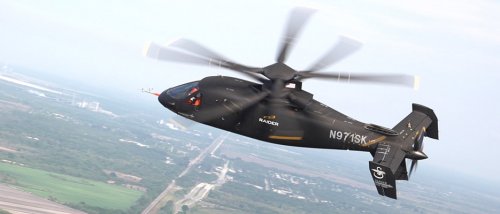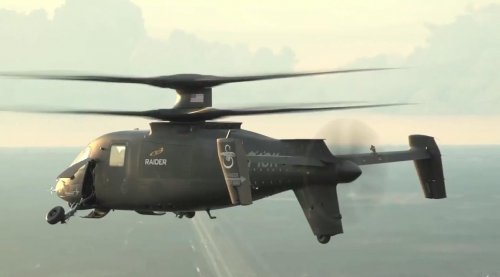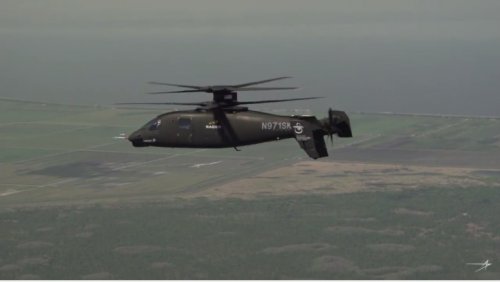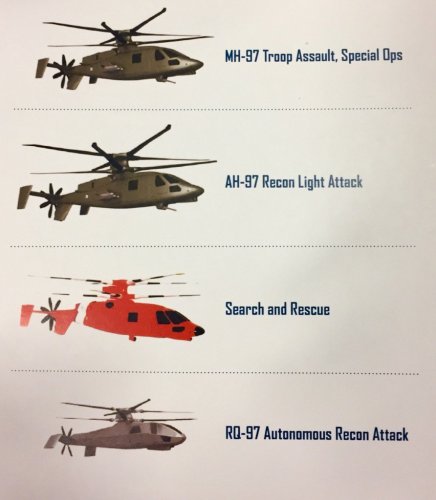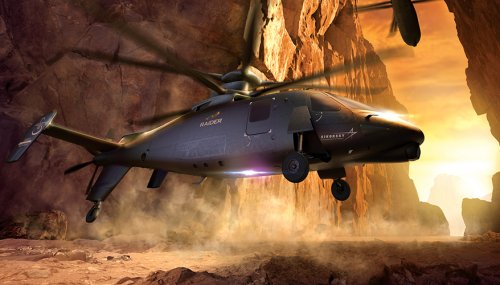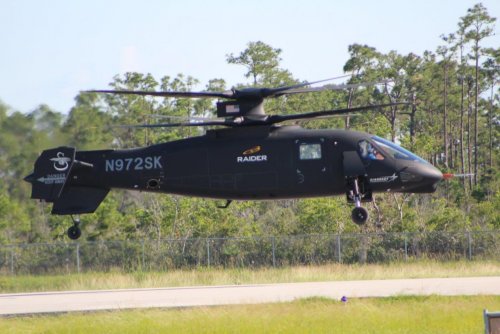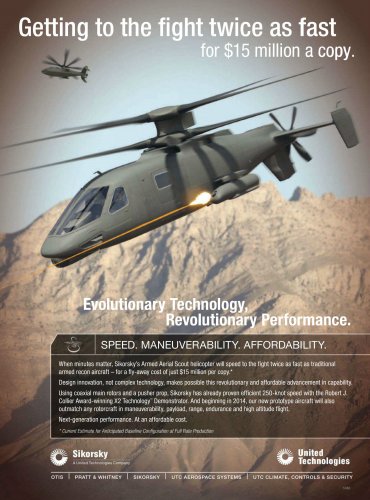QUANTICO, Va. — On a cold morning in December, a UH-1 “Huey” helicopter took off from Landing Zone Stork at Marine Corps Base Quantico. It flew about two miles before touching down in between buildings at Landing Zone Egret. After Marines on the ground unloaded cargo from the aircraft, it took off again and returned to LZ Stork. While the event might sound mundane, it could be a watershed moment in military aviation for one key reason — the Huey was performing all of these flight operations autonomously.
The demonstration of the autonomous aerial cargo/utility system prototype, also known as AACUS, offered a preview of what defense officials expect to see on future battlefields.
The technology is the product of a partnership between the Office of Naval Research and an industry team led by Aurora Flight Sciences, which is now a subsidiary of Boeing. The project has been in the works for several years. Aurora was first awarded a contract for prototype efforts in 2012.
The Marines have been using unmanned helicopters such as K-Max in Afghanistan for several years, but AACUS is different. It is not a platform, but a tool for upgrading older aircraft like the Huey to give them cutting-edge flight capabilities. It will require less input from personnel on the ground and will not be dependent on GPS for navigation, which reduces its vulnerability to electronic warfare attacks, officials said.
“This is more than just an unmanned helicopter,” ONR Executive Director Walter Jones said during remarks at the demonstration, which was attended by Marine Corps Commandant Gen. Robert Neller and other military brass. “AACUS is an autonomy kit that can be placed on any rotary-wing platform and provide it with an autonomous capability.”
Fritz Langford, the project’s chief engineer at Aurora, said the technology includes platform-agnostic computer algorithms, commercial-off-the-shelf sensors and a robust flight control system.
“It has a software package that enables it to make mission decisions on its own,” Jones explained. “It has a suite of sensors that allows it to get information from the environment to inform its decisions. And it is pushing the envelope on autonomous capabilities.”
During several flights at the Quantico demonstration, the Huey dodged obstacles such as tree lines, buildings and landing zone hazards.
Jones envisioned a scenario where Marines at a forward operating base or other austere environment could call for resupply and have it delivered without putting air crews at risk.
“Imagine for a moment that you are part of a Marine Corps company deployed in a remote location in rough terrain,” he said. “You’re low on ammunition and water and batteries or even blood, and you place a request for resupply. … An AACUS-enabled helicopter can … navigate to the location even in a GPS-compromised area, it can determine the best location for a safe landing without the need for a forward ground control station, and do all of this in low-visibility conditions.”
The technology requires very little training for warfighters, Aurora representatives noted. Marine infantryman Cpl. Christopher Osterhaus said it only took him about 15 minutes to master the tablet that communicates with the system.
“I can specify what I want, where I want it and when I want it” by typing in grid coordinates or having the technology automatically pinpoint the tablet user’s location, he said during a press conference after the demonstration.
“As far as the tablet interface, it’s incredibly comparable to [ordering] an Uber or ordering a pizza,” he said. “Once you hit ‘submit’ you get something called mission view, and it [indicates] where the aircraft is, when it’s on its way to you, when it’s about to land and when it’s on the ground.”
After the supplies are offloaded and the landing zone has been cleared, “I swipe right and as I do that the bird begins to take off,” he added.
Marine Corps leaders are gung-ho about the technology and its warfighting implications.
The capability would be ideal for distributed logistics operations, said Lt. Gen. Robert Walsh, commanding general of Marine Corps Combat Development Command and deputy commandant for combat development and integration. “Autonomy is the future of where we’re going and it really ties into manned-unmanned teaming.”
Lt. Col. Dan Schmitt, head of the field testing branch in the Marine Corps Warfighting Laboratory’s experiments division, said his team envisions other uses for this capability.
“We’re looking at everything that is possible,” he said. “We’ve already talked about a system like this dropping off smaller autonomous unmanned systems that release another autonomous unmanned capability … that impacts the electromagnetic spectrum through jammers.”
It could also potentially be used for medical evacuation, intelligence collection and fire support, he noted.
“A system with the AACUS technology may be on a logistics mission but at the same time collecting electromagnetic information and feeding that to your targeting system that employs fires,” Schmitt said.
Although AACUS was developed for the Marine Corps, other services have expressed interest. Representatives from the Army and Navy attended the demonstration, Jones noted.
The prototype program is nearing its end. The technology is slated to transition to the Marine Corps for concept-based experimentation and operational exercises in the first quarter of calendar year 2018. Performance assessments from those events will inform technology maturation efforts and future autonomy programs over the next few years, said Steve Chisarik, AACUS program manager at Aurora.
Sikorsky Autonomy Research Aircraft (Sikorsky)
Other major autonomous helicopter projects are also moving forward. The Defense Advanced Research Projects Agency has partnered with Sikorsky, a Lockheed Martin company, on its Aircrew Labor In-Cockpit Automation System program, known as ALIAS. Sikorsky has developed what it calls Matrix technology to enable autonomous flight for rotary-wing aircraft.
The ALIAS program is transitioning into phase three, said Chris Van Buiten, vice president of Sikorsky Innovations. The aim is to deliver kits to the Army for use on Black Hawk helicopters. First flight of an optionally-piloted Black Hawk equipped with the technology is scheduled for 2018, he said in an interview with National Defense.
“We’re going to have one of the oldest airframes out there become one of the most advanced in terms of flight control,” he said.
Matrix includes high performance computing, software and sensors. The super computer that enables it to work is the size of a toaster, he noted.
Warfighters can use a tablet to set broad mission parameters such as where the cargo needs to be delivered, areas to avoid and other priorities.
“The autonomy system might generate a route plan and the human might look at it and say, ‘Oh, you know, I don’t like flying down that particular valley. I’d rather you fly down this other valley to keep the mission more covert’ or whatever,” Van Buiten said.
An operator can also tell the system what’s most important for a particular mission such as minimizing flight time, noise or operating costs, he added.
The company has already tested the technology over hundreds of flights hours after installing it on the Sikorsky Autonomy Research Aircraft, or SARA.
By the early 2020s, the company will be ready to deliver military and commercial products with the Matrix technology embedded in them from the start, Van Buiten said.
“We also have the ability to do kits to modify existing aircraft,” he said. “The Army has over 2,000 Black Hawks, [so] the kit approach could be a good fit for them.”
The technology has revolutionary potential and offers several key advantages, he said. The primary one is safety. In addition to having the ability to eliminate the need to put pilots in harm’s way for certain missions, the system is expected to reduce accident rates that often result from pilot error or low-visibility conditions.
The system’s sensors can detect objects thousands of feet away and map the environment, he explained. “The computer can jam through all the calculations on the current trajectory to see if there’s an emerging issue and can intervene and manage that issue such that the helicopter won’t fly into terrain.”
The Matrix algorithms and flight control system can also operate aircraft more efficiently than human pilots, Van Buiten said. Even seasoned air crews introduce extraneous inputs into platforms during operations, he explained. The super computer cuts down on those and can manage the onset of loads on a helicopter by making calculations and moving the controls in fractions of a second.
That has implications for sustainment.
“When we have the computer fly the airplane it can … reduce the wear and tear on the components pretty significantly, so that’s direct cost reduction,” he said.
The system can also be used when human pilots are on board the aircraft, he noted. In addition to enabling autonomous flight, it can be used to assist one-man or two-man air crews. By performing some of the more mundane flight tasks, it can free up pilots to focus on the tactics of the mission, he said.
While the Defense Department is currently eyeing the technology for unmanned logistics missions, it could potentially have other uses down the road such as troop transport, Van Buiten said.
“We don’t envision going to zero-pilot [mode] with passengers on board anytime soon, but that could be in the long-range roadmap,” he said. “That only happens after we’ve got the data to prove that that could be safe.”
Sikorsky has been experimenting with the technology in its S-97 Raider system integration lab. The aircraft is a prototype high-speed helicopter designed for reconnaissance and light attack missions.
“In that facility, we’ve integrated weapon systems and the autonomy,” Van Buiten said. “There’s a remarkable operational value there in that case — the combination of the high speed and the maneuverability of the Raider platform and the autonomy and weapons to do some remarkable things.”
However, the use of autonomous systems for missions other than logistics or intelligence-gathering will require a cultural change within the Defense Department, Schmitt and Van Buiten said. Officials will have to gain confidence in the systems over time and sort through ethical issues, they added.
Nevertheless, Sikorsky expects the technology to be widely adopted, so much so that the company is pumping internal research-and-development dollars into it.
“We continue to invest significantly inside the company with our Matrix technology and we’re maturing that … for both these commercial and military customers,” Van Buiten said.
Acquiring future vertical lift platforms for logistics, reconnaissance and attack missions is one of the Army’s top modernization priorities. For FVL, the service wants unmanned and optionally-manned helicopter variants that are survivable on modern and future battlefields, he noted. That could bode well for the kind of autonomy technologies that Sikorsky is developing.
“I think that’s where our Army customer is headed,” Van Buiten said. “They’re very informed and forward-leaning in making that decision, and it will provide them remarkable flexibility on the battlefield.”
Sikorsy also delivers aircraft to the other services and the private sector, he noted. “Ultimately this technology is going to be in every Sikorsky helicopter.”
The company is already in discussions with a variety of military and commercial customers. “We are inviting a lot of them to see it and use it,” he said. “Several of them are very eager to migrate the technology into the platforms that we make for them. So stay tuned.”

